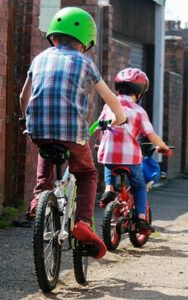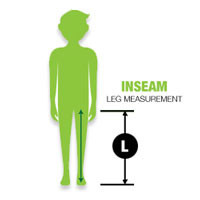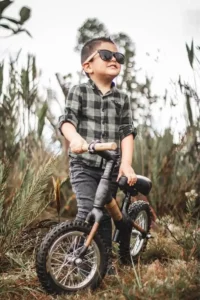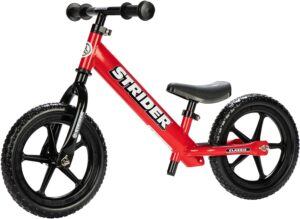
Kids Balance bikes have been around since 1997 when German designer Rolf Mertens launched the first commercial balance bike for children. His simple design has been used to create a multitude of contemporary iterations that make up today’s kids balance bike market.
For those who are new here, a balance bike is quite simply a pedaless bike that is light, easy to manoeuvre and is powered by a child’s feet walking or running on the ground.
Kids generally begin walking while standing on the bike, then walking while sitting, jogging while sitting, running while sitting and eventually gliding along as their balance, confidence and physical prowess improves.
The key concept for the design is no secret, as the name implies. Namely, balance!
Balance bikes are designed for kids to develop balance on a bike first, making an easy and smooth transition to a pedal bike when ready.
But, for parents, how are we to know which balance bike is best suited for my child?
Well, we are here to absolutely help you find the answer to that important question. In this, our latest series we are going to ride along beside you to provide everything you will need to ensure you match the correct balance bike to your unique child.
In our three-part series we will be covering the big-three factors that you will need to consider to find the best balance bike for your child and provide you with some highly-rated balance bike options in light of these elements.
Specifically, in our series we will be looking into;
- Part I – Rider Characteristics
- Part II – Balance Bike Features, and
- Part III – Riding Environments
Within each part of our series, we will also provide you with a list of highly recommended balance bike options broken down into the following age-groups;
- Toddlers (18 months to 2 years)
- Older Toddlers (2 to 3 years)
- Preschoolers (3 to 4 years)
- Older Preschoolers (4 to 5+ years)
Our recommendations directly consider the factors covered in each article, allowing you to better understand and appreciate the practical usefulness and significance of these.
As you can see, we have quite a bit of terrain to ride over here, so as is our custom, we now invite you to grab your favorite means of hydration (we highly recommend an espresso of course), kick-back and enjoy our first article in our three-part series, Which Balance Bike is Best For My Child? Part I – Rider Characteristics
Affiliate disclosure time: Some of the links on this page are affiliate links. If you click on those links and make a purchase within a time frame, we earn a small commission. Rest assured, the commission is paid by the retailers, not by you.
This commission helps keep ilovetoridemybike.com riding and writing. We thank you for your generous support. You are helping us continue doing what we love and that’s providing our customers with all the information they need to know about kids balance bikes.
Rider Characteristics
To help you decide on which balance bike will best suit your child, it is essential to begin by noting the most important aspects that will affect your purchase.
Namely, these important characteristics to consider include;
- Rider’s age
- Inseam, optimal seat height and bike’s seat height range, and
- additional qualities such as size for their age, personality and temperament
Here is a little more detail for you into each of these characteristics and how they may affect which balance bike is better suited for your little rider.
Age
Most balance bikes, generally cater for toddlers as young as 18-months up to 5+ years.
 That is, you can potentially introduce a toddler to a balance bike at 18-months and, depending on the quality of the bike and the amount of use it gets, that same balance bike may last your child until around 4 years of age.
That is, you can potentially introduce a toddler to a balance bike at 18-months and, depending on the quality of the bike and the amount of use it gets, that same balance bike may last your child until around 4 years of age.
An important note needs to be made here. A balance bike is not made for one, specific age, but an age-range.
There is a difference.
The age-range simply provides you with a guide that this bike may be suitable for your child, which is a good start, but not the number-one characteristic that determines if a balance bike will be suited for your rider.
That number-one characteristic is inseam height! Let’s take a closer look at this key characteristic together.
Inseam, optimal seat height and Seat height Range
To help you learn all about and find your child’s inseam height, head over to our post Balance Bike Set-up Guide that provides you with all the details you will need to correctly find this, how to then find the optimal seat-height for your child and finally how to make these adjustments to your bike.
Once you have found your child’s inseam and optimal seat height, its then crucial to ensure this height fits within the balance bike’s seat-height range.

Below, we provide a list of our highly recommended Balance Bikes per age-group. To keep things simple, we will use the seat-height range provided by the manufacturers for you to consider if that bike may be an option for your child.
If you haven’t already, we also recommend for you to check out our Balance Bike Buyers Guide, as this gives you in-depth descriptions and examples of how to use your child’s optimal seat-height to go balance bike shopping and, some additional balance bike features to consider (these are also covered briefly in the sections below for you).
Rider Personality
At first, this may not seem to be an important characteristic to determine which balance bike would best suit your child. However, we believe that this is an important rider characteristic worth considering when looking for a balance bike for your little riding champion.
 All children are unique. Having unique physicality, personality, disposition, temperaments, food tastes (oooh yeah) and interests to name just a few.
All children are unique. Having unique physicality, personality, disposition, temperaments, food tastes (oooh yeah) and interests to name just a few.
It is a wonderful gift as a parent to see these unique qualities surface and develop as children grow.
But what might this mean for parents wanting to introduce your child to a balance bike?
Well, for example, children that are less adventurous, a balance bike that is better suited for hard surfaces, or compact trails, that is super lightweight and easy to handle would be a better option.
For rider’s that may have some balance bike experience, who are a little older (e.g., 3-4 years) then a balance bike with air tires, a handbrake, and slightly sturdier frame would be recommended.
Below is a list of some highly rated (+ a budget pick) balance bikes per age-group, that considers the above-mentioned characteristics.
Highly Recommended Balance Bikes Per Age Group
Toddlers (18 months to 2 Years)
Cruzee Ultralite ** Top pick
Available At: Amazon.com.au (AUS $214)
Seat Height Range: 11″ – 19″
Suits Personality: Best for lighter, smaller riders who prefer hard surfaces.
Description: You have no doubt heard the expression; good things come in small packages! Well, this is certainly true for the little Cruzee. This is a great bike. At just 1.9kgs, it is also the lightest balance bike on the market. This makes the Cruzee perfect for smaller, less adventurous riders. It has a neat, tidy design with flat axle bolts, huge seat and handlebar adjustment and looks schmick with its anodized aluminum frame.
Available At: Amazon.com.au (AUS $367)

Seat Height Range: 11″ – 16″
Suits Personality: suits smaller, younger rider’s up to approximately 4 years, due to the 16″ maximum seat height adjustment. Better for hard-surface riding, and less adventurous riders.
Description: The Strider bikes have a proven track record for producing quality products that ride really well. The Strider Classic rocks the same frame and features as the Strider 12 Sport, with the only difference being the seat height range of 11″ to16″ (the Strider 12 Sport seat height range is 11″ to 19″). Therefore, this bike is best suited for riders between the 2-to-3-year age-group, that like riding more on hard, compact surfaces (due to the EVA foam tires) and no brakes.
GOMO Balance Bike
Available At: Amazon.com (USA $70) and Amazon.com.au (AUS $385)
Seat Height Range: 12″ to 17.5″
Suits Personality: Best suited for smaller, slightly less venturesome rider’s that like hard surface riding and flatter terrain.
Description: This is not only a great balance bike for younger riders, but one of our favorite budget balance bike options. This is a bang-for-your-buck bike that rocks great features for its price point. Simple design, excellent features such as easily adjustable seat and handlebars, grippy handlebar grips, aesthetic looks and footrests, this is a brilliant first bike.
Older Toddlers (2 to 3 Years)
Available At: https://woom.com (USA $199)
Seat Height Range: 10″ to 14″
Suits Personality: Due to the added hand brake and air tires, this bike handles off-road terrain really well. Therefore, we recommend for little rider’s that are a little more daring, confident, and bike energetic.
Description: Head on over to woom.com for an image.
Woom have done a great job in the balance bike market at producing quality bikes for a variety of age-groups. The Woom 1 includes some nifty safety features including a hand brake and steering limiter. Although not essential, these allow for more confident riders to test their abilities and explore varied terrains. At 3kg, it’s still relatively light, but definitely better suited to the 2-to-3-year age-range as they will be more ready to take advantage of these wonderful design features. Overall, this bike oozes quality that your child will love.
Strider 12 Sport or Strider 12 Pro

Available At: Strider 12 Sport (Amazon AUS $407) or (Amazon USA $120) and Strider 12 Pro (AUS $540)
Seat Height Range: 11″ to 19″
Suits Personality: Lightweight, practical design can be ridden anywhere. Best suited however to hard-surface riding due to EVA foam tires, no brakes or footrests. Better suited therefore for less daring, more careful riders.
Description: Head on over to Amazon.com.au for an image of the Strider 12 Pro.
As mentioned above, the Strider bikes are practical, highly recommended and super fun. They roll on EVA foam tires, so are better suited to hard surface rather than off-road riding. They come with footrests, good seat-height adjustability with quick-release clamps and safety bumpers on the grips. The Strider 12 Pro is basically the same, just lighter (2.5kg) compared to the Strider 12 Sport (3 kg). Overall, these bikes are highly reputable in the balance bike world for good reason.
Available At: Amazon.com (USA currently unavailable) and Amazon.com.au (AUS $199.95)
Seat Height Range: 12″ (with lowering kit) to 17.5″
Suits Personality: The FirstBike packs a lot into its little frame. Due to the added hand brake and air tire options this bike is well suited to adventuresome, intrepid young rider’s wanting to explore varied terrains.
Description: FirstBike comes in at 3.9 kgs and includes a nylon-composite frame, hand brake (except the Basic model), air or foam tire options, durable frame + components and a lifetime warranty. This German made little ripper is highly rated in the balance bike market, winning several awards in the industry over a long period. This is a great option for the price that includes some nifty add-on features too!
Preschoolers (3 to 4 Years)
Woom 1 Plus ** Top pick
Available At: https://woom.com (USA $269)
Seat Height Range: 15″ to 19″
Suits Personality: Specifically made for older toddlers (see description below), the Woom 1 Plus features make this bike well suited to more confident, adventurous and intrepid riders.
Description: Head on over to Woom.com for an image.
Comprising a lightweight aluminum frame weighing 9.5 lbs. (4.5 kg) and having wonderful design features including two independent v-brakes, 14″ wheels with air tires (Schrader, car-type valves), integrated ahead clamp, detachable steering limiter, surfboard footrests, aluminum seat post clamp, small 19mm diameter handlebar grips with 50cm width, it’s hard to beat this balance bike for safety and quality design.
Your child will have a blast on this bike!
smarTrike 3-in-1 Xtend

Available At: smarTrike.com (USA $223.99 current special)

Seat Height Range: 15″ to 21″ (38 to 53 cm)
Suits Personality: This bike has all the attributes to suit off-road and on-road riding and will cater for most children’s riding adventures. That being said, the bike’s extendable feature may make this bike vulnerable over time to more aggressive rider’s exploring jumps, ramps and attempting tricks.
Description: The only extendable bike on the market, smarTrike have created a bike that literally grows with your child and therefore potentially extends the bike’s longevity. The idea behind the extendable frame, is that after a period of riding the Xtend as a balance bike, you can convert this to a pedal bike and later still, extend the frame and handlebars so parents only need to purchase one bike until around 5 1/2 to 6 years.
Overall, it seems to handle really well as a balance bike, and quite well as a small bike. Basically, the smarTrike is a very good option that provides great value and is best suited for 3 years to 5-year riders.
Available At: specialized.com (AUS $280)
Seat Height Range: 13.5″ to 17″
Suits Personality: Suits adventurous, biker-getic, on and off-road riders due to its superior quality never-go-flat tires and robust frame. To put this bluntly, this bike will take a beating. The lack of handbrake however makes this better suited for flatter territory.
Description: For an image head on over to specialized.com.
Like we just mentioned, this bike will take virtually anything a young preschooler can dish out to it. While a great ride on hard-surfaces, this truly fashions its own path on off-road, hard-packed trails. The tough, A1 Premium Aluminum frame provides a very low stand over height, Rhythm Lite Airless tires are maintenance free, grippy and just like this bike, extremely durable.
Weighing in at 10lbs (4.5kg), with large footrests, padded saddle and true bearing headset this balance bike is highly recommended, and best suited to the young, rider-getic preschooler who loves to get off-road.
Older Preschoolers (4 to 5+ Years)
Strider 14x Sport Convertible Balance Bike
Available At: Amazon.com (USA $200) and Amazon.com.au (AUS $663)
Seat Height Range: 15″ to 22″
Suits Personality: Better suited for older, yet slightly shorter preschoolers (due to the shorter crank lengths) not into riding more rugged, hilly terrain with difficult obstacles.
We recommend the Strider 14x Sport for less adventurous personalities and riders that tend to ride for the sheer joy of biking and the social opportunities this affords.
Description: The Strider 14x Sport is the only Strider bike that allows you to add pedals. It’s 14″ air tires, heavier design and option to attach pedals (pedal kits available) make this suited to older preschoolers that are not far off transitioning to a pedal bike.
Overall, it does a great job as a larger balance bike. When ready, the bike can easily be converted in a matter of minutes to a pedal bike. Although a great concept, the Strider pedal kit comes with deliberately made smaller than standard pedals and shorter crank arms. This helps to make the transition from balance-to-pedal bike easy but limits the time frame that your child will use the Strider 14x Sport as a pedal bike, typically to around 12 months.
Available At: Amazon.com (USA $110) and Amazon.com.au (AUS $222)
Seat Height Range: 18″ to 22.5″
Suits Personality: One of the few 16″ balance bikes on the market, featuring a lightweight budget friendly design, air tires and no handbrake, the Bixe 16″ suits kids that are a little more apprehensive and uncertain on a bike and therefore needing extra time on a balance bike gaining confidence before making the step-up to a pedal bike.
Description: As mentioned above, the Bixe 16″ Balance bike is one of a very small number of pure 16″ balance bikes available on the market. The others being the Strider 16 Sport and the Go Glider.
That being said, there are numerous 16″, 18″ and 20″ pedal bikes available that could easily be purchased, and the pedals removed to function as a balance bike until your child is fully confident and ready to attempt using these.
This may be a great option for you, as this would allow you to potentially find a better-quality bike with added safety features, such as a brake, that will last your child for years to come.
Overall, the Bixe 16″ is a great budget option for kids needing a little extra time on a balance bike gaining confidence and bike handling skills. It’s lightweight, simple design is fun and easy to handle for older, more timid riders.
BikeBoy Balance Bike ** Budget pick
Available At: Amazon.com (USA $149-$159) and Amazon.com.au (AUS $715)
Seat Height Range: 14.5″ to 18.5″
Suits Personality: This budget friendly bike is another that easily converts from a balance bike to a pedal bike when your child is ready.
Due to the inclusion of a rear handbrake, and the option of purchasing with 16″ wheels, we recommend this bike again to a child needing a little extra time riding a balance bike gaining confidence and honing their bike handling skills before stepping-up to a pedal bike.
Best suited to more hesitant, less confident riders who like sticking to flat, hard surfaces.
Description: We like this balance bike as an overall budget friendly option for kids needing that extra time to enjoy learning to explore a balance bike at an older age-bracket. Like all budget options, the bike’s quality is not to the standard of other, mid-to-high range picks available that give you lighter frames, hidden bolts, longer crank arms and better overall quality.
That being said, the BikeBoy may provide your child with that extra time enjoying a larger balance bike, converting to a 16″ pedal bike and enjoying learning to ride a pedal bike on a bike that they already feel confident and comfortable on.
As a pedal bike, this may have a limited life-span due to its shorter crank arms and overall quality. We would suggest around 12 months use as a pedal bike, before your child may be well ready to grab a larger (20″), pedal bike that has a more robust design and additional features.
Overall ilovetoridemybike.com Conclusion
Wow, we have covered a lot of ground here. Thank you for reading this far into our post and taking the time to learn more about kids balance bikes and empower yourself with some useful knowledge that will help you make a great choice matching the right balance bike for your child.
This completes Part I in our series, which balance bike is best for my child? Just a quick re-cap, we have just learnt all about the following.
Namely, how rider characteristics including, rider’s age, inseam (+ optimal seat height + seat height range), and personality help determine which balance bike is best suited for your child.
Next up, in Part II of our series we will be looking at Balance Bike Features and how these influence our choice of balance bike for our future riding champions.
If you have any questions or comments regarding this post, or anything to do with the world of balance bike’s, feel free to leave these below, as we are more than happy to help. Let us know how you found our post, and how your child’s bike riding is going. We love to hear from you.
Happy riding!





